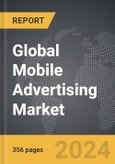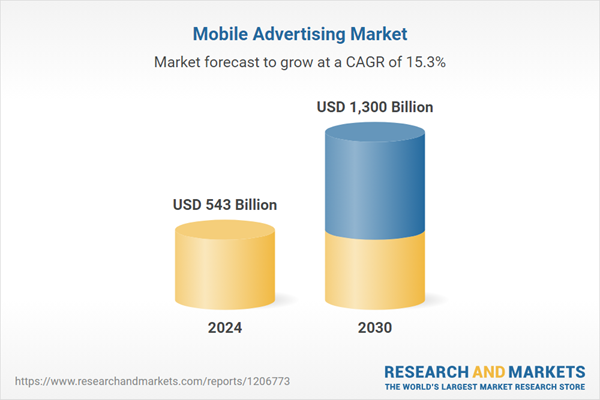The global market for Mobile Advertising was valued at US$543.0 Billion in 2024 and is projected to reach US$1.3 Trillion by 2030, growing at a CAGR of 15.3% from 2024 to 2030. This comprehensive report provides an in-depth analysis of market trends, drivers, and forecasts, helping you make informed business decisions. The report includes the most recent global tariff developments and how they impact the Mobile Advertising market.
The mobile advertising ecosystem is complex, involving a myriad of stakeholders, including app developers, ad networks, demand-side platforms (DSPs), and supply-side platforms (SSPs). The growth of programmatic advertising, which automates the buying and selling of ad inventory in real-time, has significantly enhanced the efficiency and effectiveness of mobile ad campaigns. By leveraging vast amounts of data, programmatic platforms can deliver ads to the right audience at the right time, maximizing return on investment for advertisers. Moreover, the rise of social media platforms such as Facebook, Instagram, and TikTok has created new opportunities for mobile advertising, allowing brands to engage with users in highly interactive and engaging ways. In-app advertising, in particular, has gained traction as it allows advertisers to reach users within their favorite apps, providing a seamless and integrated ad experience. Despite the immense potential, mobile advertising also faces challenges, including ad fraud, privacy concerns, and the need for continuous innovation to keep pace with rapidly changing consumer behaviors and technological advancements.
The growth in the mobile advertising market is driven by several factors. Technological advancements, such as the proliferation of 5G networks, enhance the delivery and performance of mobile ads, making them more appealing to both advertisers and consumers. The increasing adoption of smartphones and mobile devices worldwide expands the addressable market, creating new opportunities for advertisers to reach a global audience. Consumer behavior trends, including the rising amount of time spent on mobile devices and the growing popularity of mobile apps and social media, drive demand for mobile advertising solutions. The integration of AI and ML in ad targeting and personalization strengthens the business case for mobile advertising by improving the relevance and effectiveness of ads. Additionally, the shift towards video content and interactive ad formats generates increased engagement and higher conversion rates. Regulatory developments around data privacy, such as the General Data Protection Regulation (GDPR) and the California Consumer Privacy Act (CCPA), are shaping the mobile advertising landscape by encouraging more transparent and user-consent-based data practices. Overall, the dynamic nature of the mobile advertising market coupled with continuous innovation and evolving consumer preferences, ensures its sustained growth and relevance in the digital age.
Segments: Category (Display, Search, Messaging).
Geographic Regions/Countries: World; United States; Canada; Japan; China; Europe (France; Germany; Italy; United Kingdom; Spain; Russia; and Rest of Europe); Asia-Pacific (Australia; India; South Korea; and Rest of Asia-Pacific); Latin America (Argentina; Brazil; Mexico; and Rest of Latin America); Middle East (Iran; Israel; Saudi Arabia; United Arab Emirates; and Rest of Middle East); and Africa.
The analysts continuously track trade developments worldwide, drawing insights from leading global economists and over 200 industry and policy institutions, including think tanks, trade organizations, and national economic advisory bodies. This intelligence is integrated into forecasting models to provide timely, data-driven analysis of emerging risks and opportunities.
Mobile Advertising - Key Trends and Drivers
Mobile advertising has rapidly emerged as a dominant force in the digital marketing landscape, driven by the ubiquitous use of smartphones and tablets. As consumers increasingly rely on mobile devices for communication, entertainment, shopping, and information, advertisers have adapted by shifting their focus from traditional and desktop advertising to mobile platforms. This shift has been facilitated by advancements in mobile technology, including high-speed internet access through 4G and 5G networks, which enable richer and more interactive ad formats. Mobile ads now encompass a wide variety of formats, such as banner ads, video ads, native ads, and in-app advertisements, each designed to capture the attention of users in a seamless and non-intrusive manner. The integration of artificial intelligence (AI) and machine learning (ML) into mobile advertising has further revolutionized the field, enabling highly targeted and personalized ad experiences based on user behavior, preferences, and demographics.The mobile advertising ecosystem is complex, involving a myriad of stakeholders, including app developers, ad networks, demand-side platforms (DSPs), and supply-side platforms (SSPs). The growth of programmatic advertising, which automates the buying and selling of ad inventory in real-time, has significantly enhanced the efficiency and effectiveness of mobile ad campaigns. By leveraging vast amounts of data, programmatic platforms can deliver ads to the right audience at the right time, maximizing return on investment for advertisers. Moreover, the rise of social media platforms such as Facebook, Instagram, and TikTok has created new opportunities for mobile advertising, allowing brands to engage with users in highly interactive and engaging ways. In-app advertising, in particular, has gained traction as it allows advertisers to reach users within their favorite apps, providing a seamless and integrated ad experience. Despite the immense potential, mobile advertising also faces challenges, including ad fraud, privacy concerns, and the need for continuous innovation to keep pace with rapidly changing consumer behaviors and technological advancements.
The growth in the mobile advertising market is driven by several factors. Technological advancements, such as the proliferation of 5G networks, enhance the delivery and performance of mobile ads, making them more appealing to both advertisers and consumers. The increasing adoption of smartphones and mobile devices worldwide expands the addressable market, creating new opportunities for advertisers to reach a global audience. Consumer behavior trends, including the rising amount of time spent on mobile devices and the growing popularity of mobile apps and social media, drive demand for mobile advertising solutions. The integration of AI and ML in ad targeting and personalization strengthens the business case for mobile advertising by improving the relevance and effectiveness of ads. Additionally, the shift towards video content and interactive ad formats generates increased engagement and higher conversion rates. Regulatory developments around data privacy, such as the General Data Protection Regulation (GDPR) and the California Consumer Privacy Act (CCPA), are shaping the mobile advertising landscape by encouraging more transparent and user-consent-based data practices. Overall, the dynamic nature of the mobile advertising market coupled with continuous innovation and evolving consumer preferences, ensures its sustained growth and relevance in the digital age.
Report Scope
The report analyzes the Mobile Advertising market, presented in terms of units. The analysis covers the key segments and geographic regions outlined below.Segments: Category (Display, Search, Messaging).
Geographic Regions/Countries: World; United States; Canada; Japan; China; Europe (France; Germany; Italy; United Kingdom; Spain; Russia; and Rest of Europe); Asia-Pacific (Australia; India; South Korea; and Rest of Asia-Pacific); Latin America (Argentina; Brazil; Mexico; and Rest of Latin America); Middle East (Iran; Israel; Saudi Arabia; United Arab Emirates; and Rest of Middle East); and Africa.
Key Insights:
- Market Growth: Understand the significant growth trajectory of the Display segment, which is expected to reach US$999.9 Billion by 2030 with a CAGR of a 17.9%. The Search segment is also set to grow at 8.4% CAGR over the analysis period.
- Regional Analysis: Gain insights into the U.S. market, valued at $137.9 Billion in 2024, and China, forecasted to grow at an impressive 20.6% CAGR to reach $332.6 Billion by 2030. Discover growth trends in other key regions, including Japan, Canada, Germany, and the Asia-Pacific.
Why You Should Buy This Report:
- Detailed Market Analysis: Access a thorough analysis of the Global Mobile Advertising Market, covering all major geographic regions and market segments.
- Competitive Insights: Get an overview of the competitive landscape, including the market presence of major players across different geographies.
- Future Trends and Drivers: Understand the key trends and drivers shaping the future of the Global Mobile Advertising Market.
- Actionable Insights: Benefit from actionable insights that can help you identify new revenue opportunities and make strategic business decisions.
Key Questions Answered:
- How is the Global Mobile Advertising Market expected to evolve by 2030?
- What are the main drivers and restraints affecting the market?
- Which market segments will grow the most over the forecast period?
- How will market shares for different regions and segments change by 2030?
- Who are the leading players in the market, and what are their prospects?
Report Features:
- Comprehensive Market Data: Independent analysis of annual sales and market forecasts in US$ Million from 2024 to 2030.
- In-Depth Regional Analysis: Detailed insights into key markets, including the U.S., China, Japan, Canada, Europe, Asia-Pacific, Latin America, Middle East, and Africa.
- Company Profiles: Coverage of players such as 4INFO, Alibaba Group Holding Ltd., Amazon.com, Inc., Amobee, Inc., AOL, Inc. and more.
- Complimentary Updates: Receive free report updates for one year to keep you informed of the latest market developments.
Some of the 208 companies featured in this Mobile Advertising market report include:
- 4INFO
- Alibaba Group Holding Ltd.
- Amazon.com, Inc.
- Amobee, Inc.
- AOL, Inc.
- Baidu, Inc.
- Conversant LLC
- DoubleClick, Inc.
- Facebook, Inc.
- Google, Inc.
- InMobi
- LinkedIn Corp.
- Microsoft Corp.
- Oath, Inc.
- ONE by AOL
- Pandora Media, Inc.
- Tencent, Inc.
- Twitter, Inc.
- Velti
- Yahoo!, Inc.
Tariff Impact Analysis: Key Insights for 2025
Global tariff negotiations across 180+ countries are reshaping supply chains, costs, and competitiveness. This report reflects the latest developments as of April 2025 and incorporates forward-looking insights into the market outlook.The analysts continuously track trade developments worldwide, drawing insights from leading global economists and over 200 industry and policy institutions, including think tanks, trade organizations, and national economic advisory bodies. This intelligence is integrated into forecasting models to provide timely, data-driven analysis of emerging risks and opportunities.
What’s Included in This Edition:
- Tariff-adjusted market forecasts by region and segment
- Analysis of cost and supply chain implications by sourcing and trade exposure
- Strategic insights into geographic shifts
Buyers receive a free July 2025 update with:
- Finalized tariff impacts and new trade agreement effects
- Updated projections reflecting global sourcing and cost shifts
- Expanded country-specific coverage across the industry
Table of Contents
I. METHODOLOGYII. EXECUTIVE SUMMARY2. FOCUS ON SELECT PLAYERSIII. MARKET ANALYSISIV. COMPETITION
1. MARKET OVERVIEW
3. MARKET TRENDS & DRIVERS
4. GLOBAL MARKET PERSPECTIVE
UNITED STATES
CANADA
JAPAN
CHINA
EUROPE
FRANCE
GERMANY
ITALY
UNITED KINGDOM
SPAIN
RUSSIA
REST OF EUROPE
ASIA-PACIFIC
AUSTRALIA
INDIA
SOUTH KOREA
REST OF ASIA-PACIFIC
LATIN AMERICA
ARGENTINA
BRAZIL
MEXICO
REST OF LATIN AMERICA
MIDDLE EAST
IRAN
ISRAEL
SAUDI ARABIA
UNITED ARAB EMIRATES
REST OF MIDDLE EAST
AFRICA
Companies Mentioned (Partial List)
A selection of companies mentioned in this report includes, but is not limited to:
- 4INFO
- Alibaba Group Holding Ltd.
- Amazon.com, Inc.
- Amobee, Inc.
- AOL, Inc.
- Baidu, Inc.
- Conversant LLC
- DoubleClick, Inc.
- Facebook, Inc.
- Google, Inc.
- InMobi
- LinkedIn Corp.
- Microsoft Corp.
- Oath, Inc.
- ONE by AOL
- Pandora Media, Inc.
- Tencent, Inc.
- Twitter, Inc.
- Velti
- Yahoo!, Inc.
Table Information
| Report Attribute | Details |
|---|---|
| No. of Pages | 356 |
| Published | April 2025 |
| Forecast Period | 2024 - 2030 |
| Estimated Market Value ( USD | $ 543 Billion |
| Forecasted Market Value ( USD | $ 1300 Billion |
| Compound Annual Growth Rate | 15.3% |
| Regions Covered | Global |









